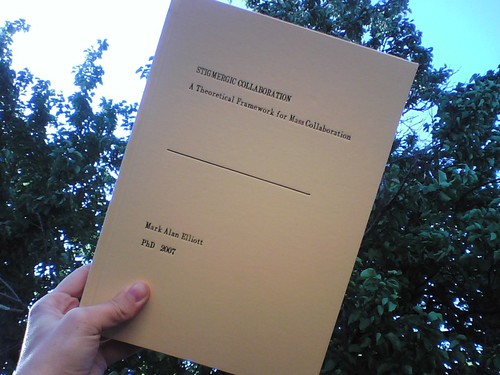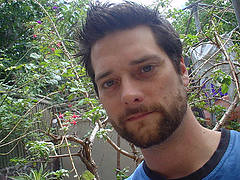PhD Completed!!!
Examined, bound and submitted - and what a good feeling it is!

I thought I might provide a general overview of my dissertation for those interested.
I was supervised by Elizabeth Presa, Sean Cubitt and Warren Burt and was examined by Howard Rheingold and Francis Heylighen. You can read the examination reports here.
Stigmergic Collaboration: A Theoretical Framework for Mass Collaboration
Abstract (first paragraph)
'This thesis presents an application-oriented theoretical framework for generalised and specific collaborative contexts with a special focus on Internet-based mass collaboration. The proposed framework is informed by the author's many years of collaborative arts practice and the design, building and moderation of a number of online collaborative environments across a wide range of contexts and applications. The thesis provides transdisciplinary architecture for describing the underlying mechanisms that have enabled the emergence of mass collaboration and other activities associated with 'Web 2.0' by incorporating a collaboratively developed definition and general framework for collaboration and collective activity, as well as theories of swarm intelligence, stigmergy, and distributed cognition.' >> full abstract
The core insight of the thesis is that mass collaboration (Wikipedia, open source software, Second Life etc) enables a shift from social to cultural negotiation, shattering the traditional glass ceiling of collaborative participation from approximately 25 members maximum, towards hundreds of thousands and beyond.
Social negotiation is the means by which all traditional collaboration takes place and is characterised by turn-taking communication. In the case of mass collaboration, a digital workspace mediates participant interaction, providing stigmergic cues to negotiate contributions via the various literacies associated with digital technologies and the particular workspace's norms, languages and 'netiquette'. While this does not preclude turn-taking communication, it places the interactive focus on cultural information which serves as the first point of engagement.
In other words, the workspace acts as a boundary object that removes social barriers to participation in online contexts (establishing, negotiating and maintaining social relations with thousands of people) and streamlines the creative process through providing a single site of work to a theoretically infinite number of participants.
Many other themes and sub-frameworks contribute to the overall work such as
- an in depth review of the state of stigmergy research and applications;
- a original, general theory of collective activity;
- an etymologically researched, cross-disciplinary, collaboratively informed definition of collaboration and the beginnings of a general theory of collaboration;
- a framework for understanding indirect, mediated communication;
- the documentation of a number of real-world projects which apply and test the findings of the thesis;
- and of course, a framework for mass collaboration which integrates the above as well as preexisting frameworks and theories.
The dissertation may be downloaded from:
I would love to hear your opinions, so please feel free to comment!
technorati tags:
phd collaboration mass collaboration stigmergic collaboration stigmergy








